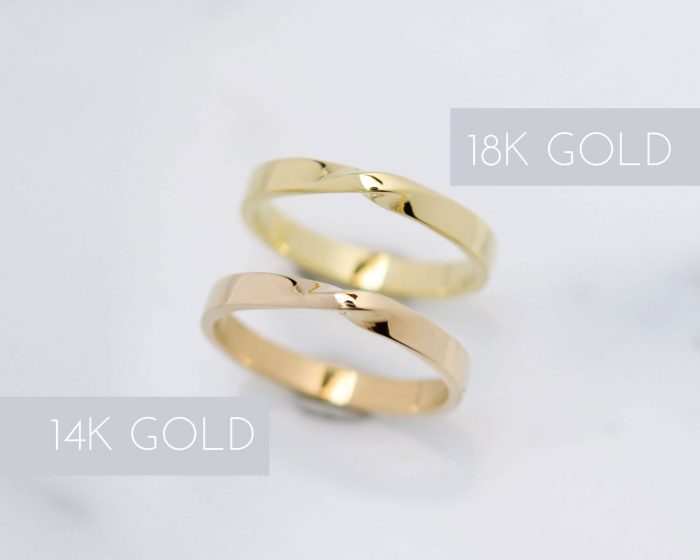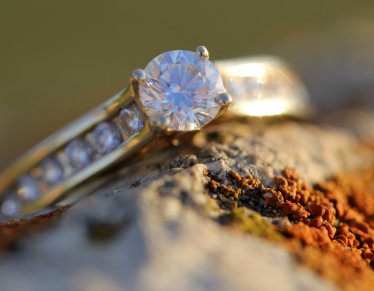If you are in the market for some new gold jewelry, you’ve got plenty of decisions to make. What do you choose when it comes to 14k vs 18k gold?
While the style of jewelry is one thing to consider, you also have to think about the gold itself. As you’ve likely seen, when buying gold jewelry, it isn’t just marked as gold, it’s labeled as 14k gold, or 18k gold, or maybe 10k gold.
What do those indicators mean? 14k and 18k happen to be two of the most popular types of gold, so we will be focusing on them today. Are they both real gold? What is the difference between them, and what is the best option when it comes to buying jewelry? Let’s talk about it!
Understanding Karats
It first helps to understand what 14k or 18k even means. For starters, the ‘k’ is short for karat, which is used to define the purity of the gold, or how much gold is actually present. Keep in mind that karat is different from carat, a term that refers to the weight and size of a gemstone (for example, a 1 carat diamond).
The numbers next to the k help clue you into how pure the gold is. The reference scale to keep in mind when it comes to karats is 1-24. 24 karat gold is pure gold. Anything under that will be a mixture, otherwise known as an alloy of gold and other metals.
To understand how much gold is present in a piece of jewelry, all you have to do is a quick bit of math (don’t worry, you can do it quickly on your smartphone!). Divide the karat number of the piece of jewelry by 24.
So, for example, if you have a 14k gold necklace, you divide 14 by 24 and times that number by 100 to get the percentage. 14/24 is 0.58, times by 100, you get 58.3% gold.
Here’s also a quick reference chart for the main types of gold and their percentages of gold (otherwise known as their gold purity):

You can see there, like we calculated, that 14k gold is 58.3% gold, and 18k gold is 75% gold. This should make sense- the higher the number is, the more pure gold that is present.
What is in an Alloy?
So, when you’ve got something like 14k or 18k gold, what makes up the other percentage? That would be an alloy of various other metals. All an alloy is a mixture of other metals that combine with pure gold to get a finished product.

Most of the time, other metals that are used in this alloy are silver, zinc, nickel, and copper. If you are dealing with yellow gold, the alloyed metals used will not change the color of the gold.
If you are dealing with either rose gold or white gold, certain metals will be alloyed in a way to change the color of the overall metal in order to produce the shade you are looking for.
Typically, more copper is used to make rose gold, and more nickel and silver are used to make white gold. With white gold, there is also usually a rhodium coating applied to the top to give it even more of a white appearance.
What About Pure Gold?
We know what you’re thinking. Why would you mix pure gold with other metals? Why not just sell pure gold, or 24k gold, in jewelry? There are a few reasons why – mainly cost and durability.
To begin with, gold is expensive! A pure 24k gold piece of jewelry would command a very high price tag. Most people would immediately not be able to afford gold jewelry if it was all 24k gold.
Say you don’t have to worry about the budget. You still would need to worry about durability. Pure gold is incredibly soft, making it an awful choice for jewelry. If you did have a piece of jewelry that was 24k gold, it would be very easily scratched and could even dent or otherwise get deformed very easily.
For this reason, you will pretty much never find a piece of jewelry for sale that is 24k gold. If you do happen to find one, not only would we recommend not buying it, we would also guess that the seller is likely lying and that the gold is not actually 24k.
Allergy Considerations
Gold, in its pure form is a great metal from an allergy perspective as it is fully hypoallergenic (and also doesn’t tarnish). However, because any gold jewelry you buy will have other metals present, you need to keep this in mind if you have any skin allergies. While this doesn’t impact a lot of people, a small percentage of people can develop a rash or irritation from certain metals, typically nickel.
If that is the case for you and you need jewelry that is hypoallergenic, we recommend going with something like platinum or palladium. ✓
14k vs. 18k Gold: A Full Comparison
For those of you who are looking to buy new gold jewelry, you’ve got a decision to make. Which karat level should you go with? Most people choose between 14k and 18k. Anything below 14k, and you will actually have more alloyed metals than you will gold.

For that reason, you should pretty easily be able to narrow down your options to 14k and 18k gold. However, deciding between those two can be a bit more tricky. Here are the top points to consider to understand the difference between the two:
✓ Gold purity: 14k gold is 58.3% gold, and 18k gold is 75% gold.
✓ Cost: Because there is more pure gold in 18k gold, it will cost more than 14k gold will.
✓ Durability: 14k gold will be more durable because it has more of those alloyed metals that increase the overall hardness of the metal. It will, therefore, be more resistant to scratches or bending.
18k gold is still fairly durable but will be more susceptible to scratches and dents than 14k gold.
✓ Appearance: Very similar. In fact, many people probably couldn’t tell the difference between 14k and 18k gold. Technically, 14k gold tends to be a bit lighter in hue since it has a lesser percentage of gold, and 18k will have a bit deeper, truer yellow/gold appearance to it.
If you are dealing with white gold or rose gold, you likely won’t tell the difference, as the color comes more primarily from the alloyed metals.
Making the Right Decision
How do you make the right decision? We recommend considering which is more important to you – budget, durability, or prestige? We personally believe that 14k gold is a perfect option for a majority of people as it combines appearance, price, and durability the best.
With 18k gold, you start to sacrifice affordability and durability, only to gain maybe a slight appearance advantage and the prestige of having 18k gold.
18k gold is more valuable from a cost perspective; however, we don’t view 14k gold as lesser or “cheap.” Some people may view it that way and hold firm that they want 18k gold. If you feel that way, understand that you will pay more for it and will have to be more careful with your jewelry.
If you are looking specifically for an engagement or wedding ring, we highly recommend going with 14k gold. You already know how expensive engagement rings can be, and going with 14k instead of 18k gold is one easy way to save money.
14k gold will also be more durable, which is something you really need to keep in mind for any jewelry you are planning to wear every day. 14k gold will hold up better when worn daily.
Wrapping Up
When buying gold jewelry, you’ll have to decide which karat percentage is right for you. For the majority of you, your final decision will be between 14k and 18k gold. While both will look incredibly similar, 18k gold has a slightly higher percentage of pure gold and will have a deeper yellow hue, whereas 14k gold will have a lighter hue, but also a lesser price tag and stronger durability.
Now that you have all the information you need, you can make the right choice! Always take your time and educate yourself before buying fine jewelry. This is a big purchase and you want to be happy with your final decision. Take into consideration all the factors in order to make the decision that is right for you.
How do you feel about gold? Are you willing to sacrifice some durability to get more pure gold, or would you rather have more durability and a lesser price tag? Let us know!




